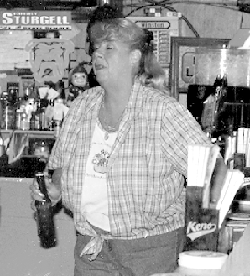

In Deale, Anti-Safeway Sentiment
Swells
J.R. Hvizda is drawn from behind the bar at Happy Harbor by the threat of a new Safeway across from her Deale home. photo by Mark Burns
Critical mass.
Borrowed from nuclear physics, the term gives us a way of understanding how things change. Suddenly, with light and energy. Which is why you get more bang out of critical mass than, say, the straw that broke the camel’s back.
For J.R. Hvizda, the woman behind the bar at Deale’s Happy Harbor Inn for 21 years, the fission happened one morning last month.
"It started," she says, "when I walked out my front door and saw them putting up a sign that said Safeway was coming."
After 28 years, 20 of them as a single mother, she’d just paid for her house on Swamp Circle Road -- across the street from Safeway’s back door.
Since that day, going door to door and business to business, she’s collected over 1,000 signatures of neighbors who, like her, are "against this development or feel that it needs more serious consideration."
Hvizda’s conversion was part of the critical mass for Deale, an unincorporated collection of homes and boats, restaurants and businesses strung along and off Maryland Route 256.
At its south end, Deale merges with Tracys Landing; at its north, it blends imperceptibly with Churchton, then turns east to Shady Side and west to West River. The well-known watering hole that is Happy Harbor is just about ground zero of the sister communities. Within a five-mile radius, 17,500 people live.
In that circle, developers proposing three shopping centers anchored
by chain supermarkets are jockeying for position. The Safeway proposal would
develop a 16-acre triangle formed by Routes 256 and 258 and Swamp Circle
Road. With 55,000 square feet, Safeway would dominate the main strip. Smaller
stores, none less than 1,200 square feet, would share the remaining area.
A fast-food restaurant would rise nearby. Runoff from the now-wooded wetland
would drain into a stormwater management pond.
Not sitting down against unbridled development, Ann Wolfe.
In addition to the Safeway complex, separate developers are negotiating to locate complexes near the intersection of Route 256 and Muddy Creek/Shady Side Road.
On Shady Side Road, Jack Smith of Smith Building Supply said he has accepted an offer of $1.5 million from a Virginia developer representing Food Lion. A Muddy Creek Road property is under separate consideration for similar use.
The three are in a horse race because -- in the current climate, with activist citizens turning away development throughout Anne Arundel and Calvert counties and Deale-Shady Side’s Small Area Planning Committtees just named -- only one is likely to win the prize.
"The one that gets its permits first is the one that’s going to get built," one county official suggested to New Bay Times.
J.R. Hvizda is one of many pushing the unaspiring little peninsula toward critical mass.
Kim Langford, owner of Pool Perfect, is among those feeling drawn in. "I’m not against development and I don’t want to be thought of as one of those people on the edge, but I just think people ought to be able to direct their own development," she said.
Langford and her husband, Wayne, say that the proposal needs more serious consideration. "I’ve been here my whole life," said Wayne Langford. "I don’t want to see the community change."
From their separate paths, Hvizda and Langford convened with three dozen other business people and citizens in a pair of recent morning meetings at Happy Harbor. Most had come simply to learn what was afoot. Rumors had every kind of development sprouting. Common wisdom had the Safeway project a done deal.
‘Is it a done deal?’ person after person aked at the Feb. 25 meeting organized by Ann Wolfe and Connie Hirschman.
Fielding their questions was Weems Duvall. As lawyer for the FoodRite across Route 258 from the proposed super-rival, Duvall claimed to "know more about the Safeway project than its developer."
"The Safeway project is definitely stoppable," Duvall told his worried audience. "If you don’t believe that, look at Franklin Point Park. When SACReD started in 1994, everybody said that was a done deal." Duvall was attorney for SACReD in their five-year crusade to save nearly 500 acres of open wetland from development as an upscale subdivision.
People worried about the environment and about their community.
Charter captain Alex Williams worried about growth. "We don’t want any major stores," he said. "The IGA [which has since affilated with the FoodRite chain] is fine."
Still, FoodRite manager Dick Christopher worried about his livelihood. He apologized for the condition to which the grocery had fallen before he took it over. He pledged "a new or enlarged store."
"We got so laid back we went to sleep," said Christopher, who’s managed the store for four years. "We had to do some homework to make the store worthy of the community."
With each concern, Duvall pushed the group nearer to critical mass. "I suggest that if this gets built, a lot of you will not be in business," he said, echoing their concerns.
You knew the movement had reached critical mass when you saw people writing $100 checks. They created the Deale/Shady Side Alliance for Rural Business, dedicated to foiling the Safeway proposal.
Their new group’s motto: "It’s not a done Deale."
--SOM
For Future Planning, A Winning
Pair -- Plus 16
photo by Mark BurnsLinda Andreasen and Billy Scerbo, two of Deale/Shady Side’s 18 citizen planners.
If Linda Andreasen and Billy Scerbo ever disagreed about development, they might want to air their differences at home.
The husband and wife, of Shady Side, both were among 18 residents and business people from 61 applicants named by Anne Arundel County Executive Janet Owens to the Deale/Shady Side Small Area Planning Committee.
Small Area Planning Committees are the front line of the county’s 1997 General Development Plan. In their year-long deliberations, citizens tailor the plan’s principles to their communities.
"Someone called and let me know that I’d been chosen," said Andreasen, the first of 18 names on the list, "and then when she got down to ‘S’ the phone rang again. I don’t think they ever caught on."
She’s right. Spokesman John Morris said the county wasn’t aware that Andreasen and Scerbo were a couple. Of course, that’s unlikely to make any difference now that the list is public, and both Andreasen and Scerbo are excited about making their contributions.
"I hope that it will be more than fun. I hope they really will take citizen input seriously," said Andreasen, a marine biologist with a federal agency. "I hope this will be a bridge between community and county."
The couple isn’t likely to disagree, by the way. "In recent years, we both have come home scratching our heads over the same things that have happenend down this way," said Scerbo, a waterman. "I’ve written letters to the county before, but this is the first time they were hiring."
Scerbo is eager to hear what people are saying, even people with different views. "I want to see what the other point of view is, whether it’s motivated totally by people’s wallets or something else," he said.
The twin-appointments could make baby-sitting tricky: The couple has a toddler and an infant -- Willy, 2, and Reggie, 3 months.
Chairing the committee is Ron Wolfe, a consultant in Arabic language and expert witness currently working on democratic processes in the Arab world. He left for three weeks in Yemen the day of his appointment.
"Having worked with people of lots of different interests, I try to find common threads and let everyone have their say. I think this is a strong group of fair-minded people," said Wolfe, a property owner in Deale since 1995.
Among others named were Jim Foster, of SACReD -- South Arundel Citizens for Responsible Development -- and M.L. Faunce, of Churchton, a contributing editor of New Bay Times and staff member retired after almost 30 years in the U.S. Senate.
So far, so good, observed Michael Shay, a local activist. "It’s a new day," he said, scanning the list.
Others named were Mohan Grover, owner of Reno’s Market in Shady Side, where he also lives with his family; Audrey Mae MacWilliams, former postmaster of Churchton, where she also lives; Tim Shearer, who ran unsuccessfully for County Council last year, of Shady Side.
Also appointed from Churchton: Jim Boyd, John Tugwell and Richard Worth.
From Deale: Trish Leisner and Deborah Whittington.
From Shady Side: Sandra Herndon, Peter Medhurst and Christine Simpson.
From Galesville: Peter Bell Sr.
Also appointed were planning groups for BWI/Linthicum, Odenton and Severn.
A kick-off celebration is scheduled for March 23, with work beginning on March 31.
--BL
In Virginia, the state’s Marine Resources Commission voted last week not to set harvest quotas on horseshoe crabs, deepening concerns about overfishing. Limits on harvests of horseshoe crabs for bait and medical uses have been decreed in Maryland, Delaware and New Jersey. So commercial operators head for Virginia, the "loophole state," where the catch increased 20-fold in recent years …
In New York, there’s good news on the
rockfish front. In nine years, the levels of PCBs (polychlorinated
biphenyls) in the lower reaches of the Hudson River have dropped
by 200 percent to about 1 part per million, which means they meet the federal
"safe to eat" threshold. Still, you shouldn’t eat ’em
every day …
In California, wineries in Napa, Sonoma and Santa Barbara got a scare last week when an e-mail purportedly from the aggressive Earth First! group threatened sabotage of vineyards in retaliation for cutting trees. Turns out the message came via a timber consultant who had his facts wrong …
Palau, the Pacific Island nation, is issuing 33-cent stamps honoring environmental heroes. Among the heroes: rock musician Sting, founder of the Rainforest Foundation International; Pulitzer Prize-winning cartoonist Jay Darling, who designed the first federal duck stamp; and Vice President Al Gore …
Our Creature Feature comes from Lake Michigan, which is suffering through a problem known in the Chesapeake Bay: disappearing alewives. But aquatic detectives think they’ve found the culprit: zebra mussels.
This invasive species native to the Black Sea and Caspian Sea arrived in the Great Lakes in the ballast water of foreign ships.
Now, they’re apparently out-competing the alewives for plankton, which both feed on. Studies near Grand Haven, Mich., support the theory: In 1997, tests showed 7,000 plankton per square meter but last year, the total fell to just 2,000.
So with the ravenous zebra mussels gobbling away, the baitfish are dying or swimming away.
Could You Have Written This?
If you can write and know of community and local events or stories of Bay interest … and if you want to try your hand at writing for Dock of the Bay, call editor Sandra Martin at 410/867-0304, Thursdays or Fridays only.